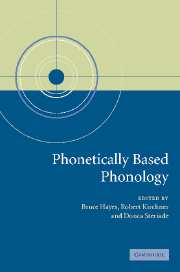Book contents
- Frontmatter
- Contents
- List of contributors
- List of abbreviations
- 1 Introduction: the phonetic bases of phonological Markedness
- 2 A review of perceptual cues and cue robustness
- 3 Place assimilation
- 4 The typology of rounding harmony
- 5 The evolution of metathesis
- 6 The role of contrast-specific and language-specific phonetics in contour tone distribution
- 7 Vowel reduction
- 8 Contrast and perceptual distinctiveness
- 9 Syllable weight
- 10 Consonant lenition
- 11 Language processing and segmental OCP effects
- Index
7 - Vowel reduction
Published online by Cambridge University Press: 21 October 2009
- Frontmatter
- Contents
- List of contributors
- List of abbreviations
- 1 Introduction: the phonetic bases of phonological Markedness
- 2 A review of perceptual cues and cue robustness
- 3 Place assimilation
- 4 The typology of rounding harmony
- 5 The evolution of metathesis
- 6 The role of contrast-specific and language-specific phonetics in contour tone distribution
- 7 Vowel reduction
- 8 Contrast and perceptual distinctiveness
- 9 Syllable weight
- 10 Consonant lenition
- 11 Language processing and segmental OCP effects
- Index
Summary
Background on vowel reduction
Vowel reduction is a well-known phonological phenomenon; the idea that certain vowels might undergo qualitative changes in unstressed positions is likely to be familiar to anyone who has taken an introductory phonology course. Because this phenomenon can be so succinctly described – that is, ‘unstressed vowels undergo neutralisation’ – it is often assumed that vowel reduction is a unitary phenomenon, with a single formal analysis. In this chapter, I take the contrary position that vowel reduction has two different mechanisms.
Acknowledging the bipartite nature of vowel reduction is key to explaining what I refer to as ‘reduction paradoxes’ – cases in which vowel reduction patterns indicate that one and the same vowel is both highly marked (i.e. tends to be subject to reduction cross-linguistically) and highly unmarked (i.e. often serves as a reduction vowel, replacing other vowel qualities that are subject to reduction). This sort of paradox can be resolved by recognising two types of constraints that focus on unstressed vowel qualities, but that have separate teleologies. One type of constraint is based on the idea of prominence, and is implemented using prominence reduction constraints (Prince and Smolensky 1993). With respect to prominence-reducing vowel reduction, unstressed /a/ is disfavoured, being a highly sonorous vowel. The other is based on the idea of contrast, and is implemented using licensing constraints; specifically, licensing constraints focusing on avoiding unstressed noncorner vowels. In this sort of vowel reduction, unstressed /a/ is favoured, since /a/ is one of the three corner vowels /i, u, a/. In what follows, I will lay out the constraints motivating these two types of reduction, their phonetic motivations, and examples of how they work.
- Type
- Chapter
- Information
- Phonetically Based Phonology , pp. 191 - 231Publisher: Cambridge University PressPrint publication year: 2004
- 20
- Cited by



